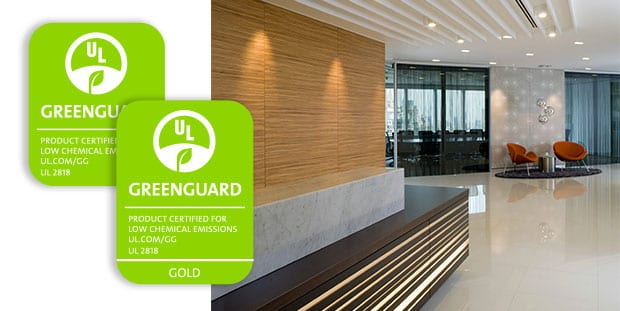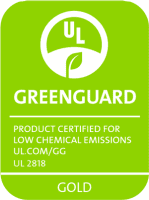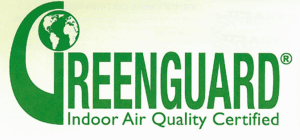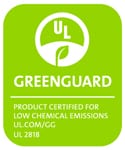
The Organization
GREENGUARD Environmental Institute (GEI) is a for-profit business unit of Underwriters Laboratories (UL), one of the most trusted testing, reporting and certifying organizations in the world. All of us are aware of the UL seal which appears on many consumer and commercial products, especially electrical and gas-powered equipment.
In 2001, Dr. Marilyn Black, a scientist specializing in indoor air quality, and founder (1989) and CEO of Air Quality Sciences, Inc. (AQS), founded GREENGUARD to set standards and test products for their effects on indoor air quality. These products include building materials, furniture adhesives and finishes, fabrics, foams and other materials used in upholstery and bedding, carpeting, and any other materials and products with the potential of affecting the quality of indoor air.
In 2011, UL acquired AQS and GEI as business units among its quality standards and testing services. As a for-profit enterprise, GEI gets paid by manufacturers for its services. Testing products not only identifies which products meet GREENGUARD standards and at which level, but test results provide feedback to help manufacturers in maintaining and improving quality.
The Third Party
Since GREENGUARD Environmental Institute is not an association to which manufacturers of tested materials belong, nor do they have a stake in the organization, the GREENGUARD seal is a third party certification. This naturally carries more weight than second party badges, such as CertiPUR-US.
Currently, GREENGUARD has two levels of certification. Here is how GREENGUARD describes its certification program: The GREENGUARD Certification Program (formerly known as GREENGUARD Indoor Air Quality Certification) gives assurance that products designed for use in indoor spaces meet strict chemical emissions limits, which contribute to the creation of healthier interiors. Achieving GREENGUARD Certification gives credence to manufacturers’ sustainability claims, backing them with empirical scientific data from an unbiased, third-party organization.
The GREENGUARD Standards



The higher level certification is called GREENGUARD Gold, established in 2005 as the GREENGUARD Children & Schools Certification. Since infants and children are more sensitive to toxic substances in the air, and it affects their development, higher standards are set, meaning there are lower thresholds and more substances covered. As an example, the following table shows the same four chemicals Essentia used to compare CertiPUR-US to GREENGUARD Gold, this time including GREENGUARD Certified:
| Chemical Name | GREENGUARD Certified | GREENGUARD GOLD | CertiPUR-US |
| TVOC | 500 µg/m3 | 200 µg/m3 | 500 µg/m3 |
| Formaldehyde | 61.3 µg/m3 | 9 µg/m3 | 100 µg/m3 |
| Benzene | — | 16 µg/m3 | 500 µg/m3 |
| Toluene | — | 150 µg/m3 | 500 µg/m3 |
We see that for Total Volatile Organic Compounds (TVOC), CertiPUR-US matches the standard for GREENGUARD Certified, and for benzene and toluene, even though the amount allowed by CertiPUR-US for these is several times that of GREENGUARD Gold, they are not covered by GREENGUARD Certified.
Why GREENGUARD
Through research during her studies and university professorship, Dr. Black saw the connection between air quality and health. Of particular concern was indoor air, since air pollution tends to be greater indoors than outdoors. People still speak of “stepping out for a breath of fresh air.” This explains why residents of southern Australia put on extra blankets in the winter so they can leave windows slightly open – it means healthier air.
When you read reviews of mattresses, there are references to “outgassing” from foams. There is very little from latex (a.k.a. “foam rubber”), but is a problem with polyurethane and memory foam. This is the release of fumes from the petrochemicals in the foam, byproducts of curing and aging of the foam.
Outgassing is greatest when the new mattress is removed from its packaging, with a very noticeable odor. It continues at a lower and diminishing level long after the odor disappears, in fact for the lifetime of the foams. Several of the fumes are odorless, but some can be more harmful than those we smell.
Not all outgassing is from foams. Some adhesives outgas harmful substances, especially formaldehyde, which has been notorious in building materials and construction. Many foam mattresses use adhesives to bond layers for the integrity of the mattress as a whole. Some mattress brands, such as Tempflow, use water-based adhesives which are certified by GREENGUARD as not emitting formaldehyde.
Testing methods developed under the leadership of Dr. Black detect the level of these fumes and the amount in the air of different sized rooms. It was the accuracy of her testing that prompted Underwriters Laboratories to bring GREENGUARD under its umbrella.
According to Wikipedia, GREENGUARD Environmental Institute is certified by the International Organization for Standards (ISO) as a third party certifying body, meeting the ISO-IEC Guide 65:1996 accreditation standards.
Companies Using GREENGUARD
According to Wikipedia, over 10,000 items are certified by GREENGUARD. This includes more than bedding and upholstery, but also building materials, cleaning products, and other kinds. Still, several producers of mattresses are listed. A few of them are Dorel Home Products, Lullaby Earth, Naturepedic, Organic Mattresses Inc., Savvy Rest, Inc., Sealy, Serta Crib Mattresses, Simmons Kids, and Stearns & Foster.
GREENGUARD Gold is one of the coveted certifications for infants’ and children’s mattresses, because of its high standards in regard to 36 chemicals which may be present in bedding foams.

